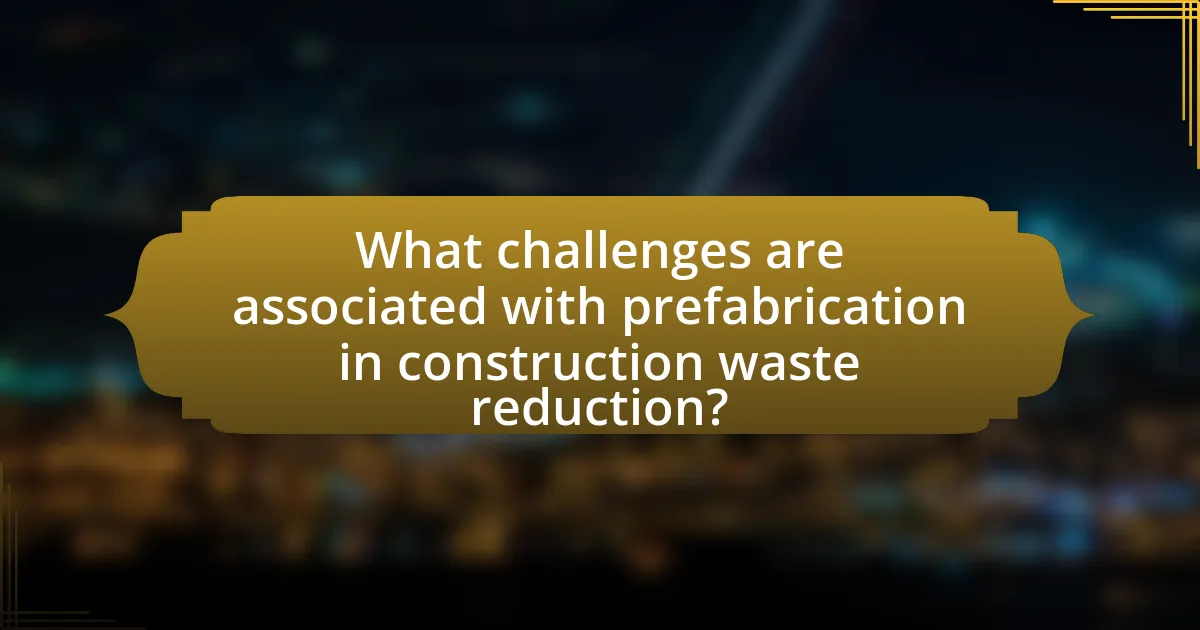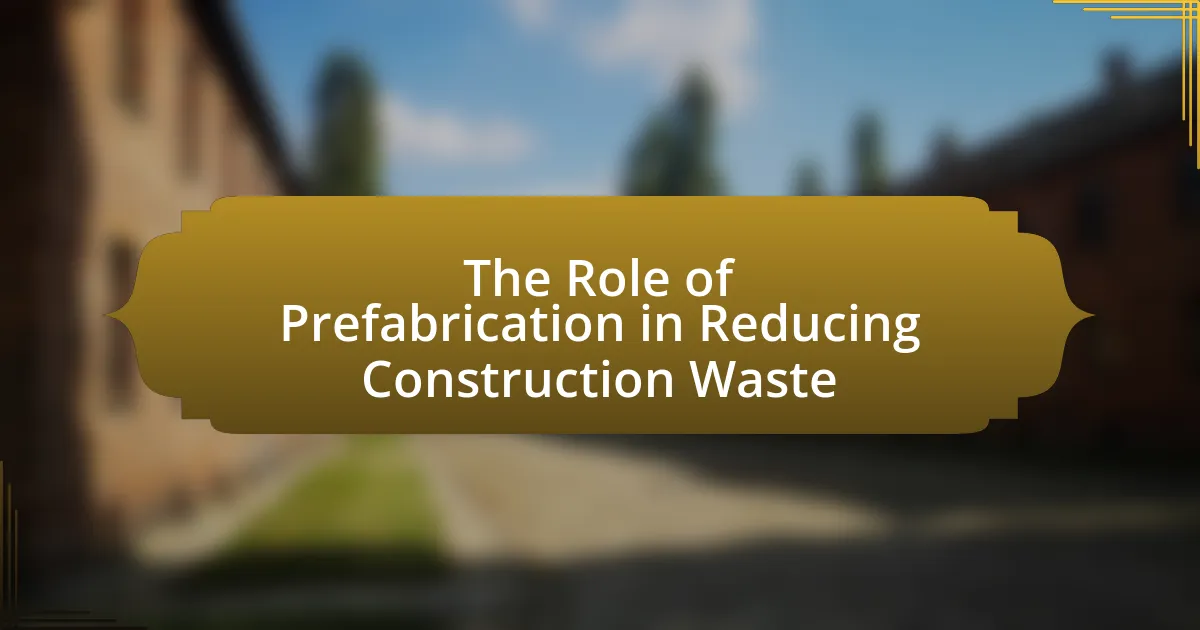Prefabrication is a construction method that significantly reduces waste by manufacturing components in controlled environments, leading to up to a 30% decrease in material waste compared to traditional building practices. This article explores how prefabrication enhances material efficiency, streamlines construction processes, and improves project timelines while addressing the environmental impacts of construction waste. Key processes such as modular design, precise manufacturing, and efficient logistics are examined, alongside the economic advantages and challenges associated with prefabrication. Additionally, the article discusses common misconceptions and best practices for successful implementation, emphasizing the importance of collaboration among stakeholders to maximize the benefits of prefabrication in waste reduction.

What is the role of prefabrication in reducing construction waste?
Prefabrication plays a crucial role in reducing construction waste by allowing components to be manufactured in a controlled environment, which minimizes material waste and enhances precision. This method leads to a significant reduction in on-site waste, as studies indicate that prefabricated construction can reduce waste by up to 30% compared to traditional building methods. Additionally, prefabrication streamlines the construction process, leading to fewer errors and less rework, further contributing to waste reduction.
How does prefabrication contribute to waste reduction in construction?
Prefabrication significantly contributes to waste reduction in construction by allowing components to be manufactured in a controlled environment, which minimizes material waste. In traditional construction, materials are often cut and assembled on-site, leading to excess scraps and inefficiencies. A study by the National Institute of Standards and Technology found that prefabrication can reduce construction waste by up to 30% by optimizing material usage and improving precision in manufacturing. This method not only decreases the volume of waste generated but also enhances recycling opportunities, as off-cuts and surplus materials can be more easily repurposed in a factory setting.
What are the key processes involved in prefabrication that minimize waste?
The key processes involved in prefabrication that minimize waste include modular design, precise manufacturing, and efficient logistics. Modular design allows for the creation of standardized components that can be easily assembled, reducing the need for excess materials. Precise manufacturing techniques, often conducted in controlled factory settings, ensure that materials are cut and shaped accurately, which minimizes off-cuts and scrap. Efficient logistics streamline the transportation of prefabricated components, reducing the carbon footprint and waste associated with traditional construction methods. These processes collectively contribute to a significant reduction in construction waste, with studies indicating that prefabrication can reduce waste by up to 30% compared to conventional building practices.
How does prefabrication impact material efficiency?
Prefabrication significantly enhances material efficiency by minimizing waste during the construction process. This method allows for components to be manufactured in a controlled environment, leading to precise measurements and reduced excess material. Studies indicate that prefabrication can reduce material waste by up to 30% compared to traditional construction methods, as it allows for better planning and utilization of resources. Additionally, the assembly of prefabricated components on-site requires fewer materials, further contributing to overall efficiency and sustainability in construction practices.
Why is reducing construction waste important?
Reducing construction waste is important because it minimizes environmental impact and promotes resource efficiency. Construction activities generate approximately 40% of global waste, leading to increased landfill use and greenhouse gas emissions. By reducing waste, the construction industry can conserve natural resources, lower project costs, and enhance sustainability. For instance, implementing prefabrication techniques can reduce material waste by up to 30%, as components are manufactured in controlled environments, allowing for precise measurements and less excess material. This approach not only benefits the environment but also improves project timelines and reduces labor costs.
What are the environmental impacts of construction waste?
Construction waste significantly impacts the environment by contributing to pollution, habitat destruction, and resource depletion. The disposal of construction debris in landfills leads to soil and water contamination due to leachate, which can contain hazardous materials like heavy metals and chemicals. According to the Environmental Protection Agency, construction and demolition debris accounted for approximately 600 million tons of waste in the United States in 2018, representing a substantial portion of total waste generated. Additionally, the extraction and processing of raw materials for construction contribute to deforestation and biodiversity loss, further exacerbating environmental degradation.
How does construction waste affect project costs?
Construction waste significantly increases project costs by necessitating additional expenses for disposal, labor, and materials. The presence of waste leads to inefficiencies, requiring contractors to spend more time and resources managing excess materials rather than focusing on the project itself. For instance, a study by the National Institute of Standards and Technology found that construction waste can account for up to 30% of total project costs, highlighting the financial impact of poor waste management. Additionally, the need to replace wasted materials further inflates costs, as purchasing new materials incurs additional expenses. Thus, effective waste management strategies, such as prefabrication, can mitigate these costs by reducing the amount of waste generated on-site.

What are the benefits of prefabrication in construction waste management?
Prefabrication in construction waste management significantly reduces material waste and enhances efficiency. By manufacturing components off-site in controlled environments, prefabrication minimizes the likelihood of errors and excess materials, leading to a reduction in waste generation. Studies indicate that prefabricated construction can reduce waste by up to 30% compared to traditional methods, as it allows for precise measurements and optimized material usage. Additionally, the streamlined assembly process on-site further decreases the time and resources spent, contributing to overall sustainability in construction practices.
How does prefabrication improve project timelines?
Prefabrication improves project timelines by enabling components to be manufactured off-site while site preparation occurs simultaneously. This parallel processing reduces the overall construction duration, as studies indicate that prefabricated projects can be completed up to 30% faster than traditional methods. Additionally, the controlled factory environment minimizes delays caused by weather and site conditions, further streamlining the construction process.
What role does prefabrication play in enhancing labor efficiency?
Prefabrication significantly enhances labor efficiency by allowing construction components to be manufactured off-site in controlled environments, which reduces on-site labor requirements. This method streamlines the construction process, as tasks such as assembly and installation can be completed more quickly and with fewer workers. According to a study by the National Institute of Standards and Technology, prefabrication can reduce labor costs by up to 20% and construction time by 50%, demonstrating its effectiveness in improving labor efficiency in the construction industry.
How does prefabrication facilitate better quality control?
Prefabrication facilitates better quality control by allowing components to be manufactured in a controlled factory environment, where conditions can be optimized for precision and consistency. This controlled setting reduces the variability associated with on-site construction, leading to higher quality standards. For instance, studies have shown that prefabricated components can achieve up to 90% fewer defects compared to traditional construction methods, as factory processes can be standardized and monitored closely. Additionally, the use of advanced technologies in prefabrication, such as automated machinery and quality assurance protocols, further enhances the reliability and durability of the final product.
What are the economic advantages of using prefabrication?
The economic advantages of using prefabrication include reduced labor costs, shorter construction timelines, and minimized material waste. Prefabrication allows for components to be manufactured in a controlled environment, which leads to increased efficiency and lower labor expenses due to less on-site work. According to a study by the National Institute of Standards and Technology, prefabrication can reduce construction time by up to 50%, which translates to significant savings in overhead costs. Additionally, prefabrication minimizes material waste by optimizing the use of resources during the manufacturing process, leading to cost savings and a more sustainable construction approach.
How does prefabrication reduce overall project costs?
Prefabrication reduces overall project costs by streamlining construction processes and minimizing labor expenses. By manufacturing components off-site in controlled environments, projects can achieve faster assembly times and reduce on-site labor requirements, which typically account for a significant portion of construction costs. Additionally, prefabrication leads to less material waste, as precise manufacturing techniques allow for better material utilization. According to a study by the National Institute of Standards and Technology, prefabrication can reduce construction costs by 10-20% due to these efficiencies and waste reductions.
What financial incentives exist for adopting prefabrication?
Financial incentives for adopting prefabrication include reduced labor costs, shorter construction timelines, and potential tax benefits. Prefabrication allows for off-site construction, which can lead to a 20-50% reduction in labor costs due to increased efficiency and less on-site workforce requirements. Additionally, projects utilizing prefabrication can be completed 30-50% faster, resulting in lower overhead costs and quicker return on investment. Some regions offer tax incentives or grants for sustainable building practices, which can further enhance the financial appeal of prefabrication.

What challenges are associated with prefabrication in construction waste reduction?
Prefabrication in construction waste reduction faces several challenges, including logistical complexities, quality control issues, and limited design flexibility. Logistical complexities arise from the need for precise coordination between manufacturing and construction sites, which can lead to delays and increased costs if not managed effectively. Quality control issues can occur due to the mass production of components, where defects may go unnoticed until assembly, resulting in waste. Limited design flexibility is another challenge, as prefabricated components often require standardization, which can restrict innovative design solutions and adaptability to specific project needs. These challenges can hinder the overall effectiveness of prefabrication in achieving significant waste reduction in construction projects.
What are the common misconceptions about prefabrication?
Common misconceptions about prefabrication include the belief that it compromises quality, is only suitable for simple designs, and is more expensive than traditional construction methods. In reality, prefabrication can enhance quality through controlled manufacturing environments, allows for complex designs due to advanced technology, and can be cost-effective by reducing labor and construction time. Studies show that prefabricated components can lead to a 20-30% reduction in construction waste, supporting the argument that prefabrication is a viable and efficient alternative in the construction industry.
How can these misconceptions hinder the adoption of prefabrication?
Misconceptions about prefabrication can significantly hinder its adoption by fostering skepticism regarding its cost-effectiveness and quality. For instance, many stakeholders believe that prefabricated components are inferior in quality compared to traditional construction methods, which can lead to reluctance in investment. A study by the National Institute of Standards and Technology found that prefabrication can reduce construction waste by up to 30%, yet misconceptions about durability and design flexibility prevent potential users from realizing these benefits. Additionally, the belief that prefabrication is only suitable for specific types of projects limits its application across various construction sectors, further stalling its widespread acceptance.
What are the limitations of prefabrication in certain projects?
Prefabrication has limitations in certain projects, primarily due to site-specific constraints, design flexibility, and transportation challenges. Site-specific constraints can hinder the installation of prefabricated components, especially in urban areas with limited access or complex site conditions. Additionally, prefabrication often requires precise design specifications, which can limit flexibility in adapting to changes during construction. Transportation challenges arise when large prefabricated elements must be moved to the construction site, potentially leading to increased costs and logistical complications. These factors collectively restrict the applicability of prefabrication in various construction scenarios.
How can stakeholders overcome challenges in implementing prefabrication?
Stakeholders can overcome challenges in implementing prefabrication by fostering collaboration among all parties involved, including architects, engineers, and contractors. This collaboration ensures that design and construction processes are aligned, which minimizes misunderstandings and errors. For instance, a study by the National Institute of Standards and Technology found that improved communication can reduce project delays by up to 30%. Additionally, stakeholders should invest in training and education to enhance the skills necessary for prefabrication techniques, as a skilled workforce is crucial for successful implementation. By addressing these areas, stakeholders can effectively navigate the complexities associated with prefabrication and contribute to reducing construction waste.
What best practices should be followed for successful prefabrication?
Successful prefabrication requires meticulous planning, effective communication, and adherence to quality standards. First, thorough design and engineering should be conducted to ensure that components fit together seamlessly, reducing the likelihood of errors during assembly. Second, collaboration among all stakeholders, including architects, engineers, and contractors, is essential to align expectations and streamline processes. Third, implementing quality control measures throughout the manufacturing process ensures that prefabricated components meet specified standards, minimizing defects and rework. Additionally, utilizing advanced technologies such as Building Information Modeling (BIM) can enhance accuracy in design and facilitate better project management. These practices collectively contribute to reducing construction waste by optimizing resource use and minimizing on-site errors.
How can collaboration among stakeholders enhance prefabrication outcomes?
Collaboration among stakeholders enhances prefabrication outcomes by improving communication, aligning objectives, and streamlining processes. When architects, engineers, contractors, and suppliers work together, they can identify potential issues early, leading to more efficient designs and reduced waste. For instance, a study by the National Institute of Standards and Technology found that collaborative project delivery methods can reduce construction time by up to 30% and waste by 20%, demonstrating the tangible benefits of stakeholder collaboration in prefabrication.
What practical steps can be taken to maximize the benefits of prefabrication in reducing construction waste?
To maximize the benefits of prefabrication in reducing construction waste, construction companies should implement standardized designs and modular components. Standardization allows for precise manufacturing, minimizing material excess and errors during assembly. Additionally, utilizing advanced software for Building Information Modeling (BIM) can enhance planning accuracy, leading to reduced waste generation. Research indicates that projects using prefabrication techniques can achieve waste reductions of up to 30% compared to traditional methods, as reported by the National Institute of Standards and Technology. Furthermore, establishing strong partnerships with suppliers ensures that materials are delivered just-in-time, reducing the likelihood of over-ordering and subsequent waste.

Leave a Reply